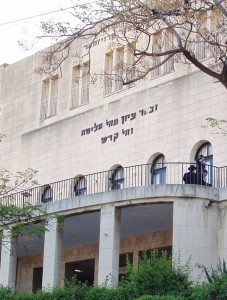The Haftarah of VaYishlach is the entire book of Ovadiah . It is addressed to Edom, the nation founded by Esav.
Linear Annotated Translation of the Haftarah of VaYishlach
There are several connections where the Haftarah gives us additional perspective on the Parsha:
As a special bonus, the following shows how an understanding of the Haftarah can affect Jewish History itself:
The Haftarah says, in verse 17:
וּבְהַר צִיּוֹן תִּהְיֶה פְלֵיטָה וְהָיָה קֹדֶשׁ
But in MountTzion there will be refuge, and it will be holy.
The somewhat unusual phrase “refuge” is also used in the Parsha: as Yaakov prepares his family for a possible war with Esav, he splits them into two camps:
(ט) וַיֹּאמֶר אִם יָבוֹא עֵשָׂו אֶל הַמַּחֲנֶה הָאַחַת וְהִכָּהוּ וְהָיָה הַמַּחֲנֶה הַנִּשְׁאָר לִפְלֵיטָה:
He said: “If Esav will come to one camp and destroy it; the remaining camp will be a refuge. (Breishit 32:9)
Yaakov’s actions have served as a paradigm in Jewish history. In every generation, the Jewish people are threatened. Sometimes G-d saves us; at other times one of our camps is destroyed, and the other serves as a refuge. As Jerusalem was destroyed, there was Bavel, when Bavel faltered, there was Spain and France, as Spain was destroyed, there was North Africa and Eastern Europe.
Since the destruction of the First Temple, the surviving camp has never been in Jerusalem. But this time, says the prophet, it will be Tzion that is the refuge – this time, G-d will not let anyone touch it. It will be “holy”, as in “kodesh LaHashem” – dedicated to G-d, set aside for Him, inviolate.
This verse from Ovadiah, “In Mount Tzion there will be refuge”, is inscribed on the building of the Ponevezher Yeshiva in Bnei Brak. The story is told[1] about Rav Yosef Kahaneman, whose huge Torah institution in the Lithuanian town of Ponevezh, was completely destroyed by the Nazis. Just before the war started, he managed to escape on a special visa, and made his way to Eretz Yisrael. Despite having lost everything, his entire life’s work, in 1944 Rav Kahaneman purchased land in a barren lot near Tel Aviv, and excitedly told everyone there would be a Yeshiva there. People thought he was insane – German troops were heading for Palestine! They were about to be occupied by the Nazis and destroyed! What Yeshiva?!
Yet, at that time, it was clear to Rav Kahaneman, that the time for the words of Ovadiah had come: this time, the refuge, the surviving community, would be in Tzion, and it would need to be “kodesh”.
[1] See “Builders: R’ Kotler, R’ Kahaneman, and Sarah Schneirer”, by Hanoch Teller

